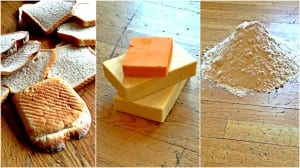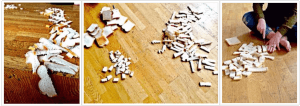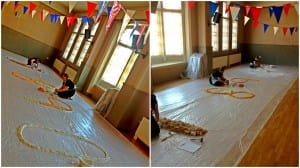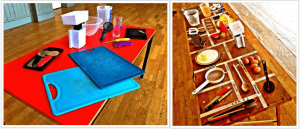
Bread and Cheese Hall
Framing Statement
Bread and Cheese Hall was a site specific performance that took place on the 4th of May 2016 in the Cosker Room situated within the Lincoln Drill Hall. This durational piece lasted three hours and therefore permitted the audience to witness as much or as little as they desired. The performance was inspired by the history of the Drill Hall itself and how it became to be the establishment that it is today.
Over time, there have been many historical and memorable events to have occurred within The Drill Hall, however, our piece was based on events that happened before the construction took place, starting with the man who paid for the building in 1890, Joseph Ruston. Ruston was already a partner in the agricultural engineering firm ‘Ruston, Proctor and Co.’, in which the workers from this business demanded a pay rise, which he rejected with the reply “I hope you’ll let me get bread and cheese out of my business!” consequently nicknaming him ‘Mr Bread and Cheese’. When Ruston further went on to pay for the Drill Hall after claiming he was unable to higher his workers’ wages, the workers named the building, ‘Bread and Cheese Hall’. We decided this would be an interesting aspect to investigate further and how we could somehow physically create bread and cheese hall within the Drill Hall to demonstrate this history in a building that is vastly different in today’s modern day. The Drill Hall itself claims it is a place to ‘have experiences that you just can’t find elsewhere’, therefore we wanted to fulfil this by creating a site specific experience that is vastly different from anything ever performed there before.
Analysis of Process
Initially our idea was to create a sculpture of the Drill Hall out of the raw materials of bread and cheese itself. However, after planning this we didn’t think this idea had enough depth or the ability to show the history we wanted to portray, whilst this idea would also have been simultaneously too difficult to physically construct.
Whilst deciding how else we could approach our idea surrounding bread and cheese, we looked into the use of audio and how it could be used to accompany our performance. This is where we found the work of the well-known site specific artist Janet Cardiff. Cardiff’s work primarily focuses on sound and sound installation. A form of work that she is known for is what she calls ‘audio walks’, which consist of recorded voices heard through the use of speakers and headphones, which simultaneously play varying narrations. For our own site specific piece, we were interested in the use of sound and video, in particular the use of voice recording and creating video montages. This is an idea that Janet Cardiff presents within her piece named ‘40 Part Motet’. The ‘40 Part Motet’ consists of using multiple speakers at the same time laid out in a symmetrical circle within a room and layering individual sounds or narrations from each speaker to create one complete sound that is heard throughout the room. This technique is effective and gives the audience the opportunity to either focus on one speaker or enjoy the conflicting sounds coming together as one. Cardiff herself suggested this was so that ‘Every performer hears a unique mix of the piece of music. Enabling the audience to move throughout the space allows them to be intimately connected with the voices’ (Cardiff, J. 2001).
In relation to our performance we decided we wanted to explore this using multiple speakers to create differing sounds within our piece. One idea we discussed was to use numerous industrial sounds such as machinery to demonstrate the factory of Joseph Ruston and to signify the importance that his business meant to him. Therefore we explored having opposing machinery sounds in multiple speakers around the room to create the illusion of a type of factory. At the same time as this, we discussed having a projector to display a more natural side of the process of making bread to juxtapose the heavy machinery. Cardiff’s idea of intimacy intrigued us as we wanted to create a similar presence to our performance.
An example of one of the videos we were orgienally going to use within our performance (Goddard, 2016).
From this, our next step was to find another way we could still use bread and cheese within our piece, we thought this was an interesting approach into the Drill Halls history and would create a performance that would intrigue the audience. Consequently we decided that we would use the dimensions of the Drill Hall instead and researched into finding a floor plan of the entire building. Once we had sourced this, we scaled the measurements down to make smaller version of the building, yet still somehow mirroring the Drill Hall itself. For example, we suggested that for every metre we would scale down into centimetres and therefore we could present a smaller, but still accurate representation of the Drill Hall using slices of bread. We experimented how we would do this first with small cut outs of paper, to gain a clearer idea of what the final piece would look like, before trying to demonstrate it with the food resources we actually wanted to use in the final performance. When experimenting with the paper cut outs we came up with the idea of cutting the bread into thin rectangle shapes and placing them in the lines of the floor plan to clearly demonstrate the shape that we wanted to. When we started to cut bread in this manor, we discovered we were cutting what looked like ‘soldiers’ that are often associated with bread or toast. This triggered an idea that we could relate this form of ‘bread soldiers’ to military soldiers as the Drill Hall is highly well known for its military background hence forth bringing multiple parts of the Drill Hall’s history together into one performance.

The floor plan that we created out of pieces of paper (Goddard, 2016)
The floor plan we created out of bread ‘soliders’ (Goddard, 2016)
Through the development of our work, we have been influenced by not only other site specific artists, but also the work of other artists and sculptors too. In particular we found the work of the sculptor Antony Gormley interesting, mainly because in many of his pieces he has often worked with the material bread. This helped guide many of our initial ideas as we intended on using bread to somehow mould into diverse shapes such as these ‘soldiers’ we had decided to create.
A piece that we found predominantly significant was created by Antony Gormley in 1980-1981 and was called ‘Bed’. This was a sculpture of a bed made out of 600 loaves of bread with Gormley’s silhouette cut, or rather eaten out of it. He states that the reasoning for the use of bread is that it ‘seems to express something about our relationship with the material world’ (Gormley, A 2015). He shows a particular interest into the bread being as far away from natural than it could get, ‘it’s square, it’s been divided, its metonymy is now of absolute 8mm thick slices’(Gormley, A 2015). Within an interview with Anthony Gormley he suggests that this industrialisation of bread represents how life has become more regimental for people and how this is reflected through his sculpture ‘Bed’. The reasoning for the sculpture being in the shape of a bed is because it is ‘the usual location for conception, birth and death, [therefore] becomes the ground for the transformative processes of life itself.’ (Gormley, A 2015). This shows the connection between using a raw material such as bread, that has been constantly adapted over time and intertwining it with the concept of everyday life and an everyday object such as a bed. The depth within this piece intrigued me to give our performance more focus on the progression of bread and the reasoning for this.

I found this particularly interesting as within our piece we have looked into the structure of the bread itself and how it can be cut into figures that could portray different ideas and concepts. Because Gormley’s structure of a bed could be seen as symbolic for everyday life, we felt that in connection to the Drill Hall, the idea of cutting the bread into individual strips would help to emphasise the history of the building. Whilst researching Antony Gormley and his work we discovered that many of his ideas also related to the history that we were looking at in our own performance. For example the industrialisation that Gormley states to do with why he used bread as a material for his sculpture interested us. The origin of the nickname ‘Bread and Cheese Hall’ was due to Joseph Ruston’s dedication to his business emphasising the importance of ‘business’ and development within this line of work. This related to the industrialisation of bread that Antony Gormley touches on as he stresses that bread has become distanced from the natural, due to the rise in manufacturing businesses and the decrease in organic substances.
How the performance altered and developed
After researching into this industrialisation of bread and how it has become processed, we decided this would be a further interesting angle to approach our performance. For example we decided to look into not only bread, but also the development of both cheese and flour as well. This is due to bread and cheese being our centre idea and whilst working around this, we found that we were drawn to the use of flour and how it could be easily manipulated and decided to bring this third element into the performance. These three substances then became the main focus of our piece and we particularly liked how these three materials could be handled and changed just like they had been in industrialisation over the years.
Therefore, after recent findings we decided to change our performance vastly. We liked the aesthetics of the three materials placed in three separate piles throughout the room. This is where we decided we would perform in The Cosker Room situated upstairs in the Drill Hall as this room was shaped long and rectangular, with large windows and had patriotic coloured bunting placed throughout the room. This room was particularly interesting as its long layout would be able to display the three materials clearly and the windows provided the room with a large amount of natural day light that we thought would emphasise our piece. The bunting was one element that particularly drew us to this room, as it provided us with a sense of nostalgia, I felt it had some form of connotations to nationalism and baking which we felt were somehow related to the development and alteration of natural products over time. It has been suggested that the ‘location can work as a potent mnemonic trigger, helping to evoke specific past times related to a place’ (Pearson, M. 2010 p9) therefore we thought this aesthetic would help provide the performance with a sense of relation to 1890. Here, we also decided to create the figure of ‘1890’ out of the materials we were using during the second hour of our performance. This was in order to show how the materials have evolved and to incorporate some of our earlier ideas of exploring sculptures as a way of symbolising events in history, for example the year that Joseph Ruston famously paid for the Drill Hall to be built.

For our performance we wanted to emphasise the importance of the idea of a ‘business’ and how natural products had become manipulated through large corporations in recent years. Therefore for our final performance we decided to portray a form of business to do with bread, cheese and flour. We decided to simply slice bread, chop cheese and move the flour from the floor into bowls. This idea was to suggest a largely regimented sense of business as if we were working in a factory repeating the same work continuously. However to show this deterioration of the natural, we decided that every hour the materials would become further and further manipulated using different appliances. This is where we decided to split the time into three hours, the reason we choice this time scale was because the three performers would rotate between the three stations of the three elements every hour and this fitted with our idea of having a very fixed, disciplined business. Subsequently, the last hour would result in a form of chaos to portray the deterioration of the natural and to emphasise how much the materials have been altered.

One of our final ideas was inspired by the performance artist Marina Abramović. A piece Abramović created that we found particularly interesting was a 6 hour performance called ‘Rhythm O’ in 1974. Within this performance she presented 72 objects laid out on a table to the audience in which they could use in whatever way they wanted to, with the artist herself as the object. This performance was all with the intention of seeing, to what extent the audience members would go to using these materials. The materials vastly changed throughout the performance ranging from minor items such as a feather to the more extreme objects such as a knife and a loaded gun. These were random objects provided by Marina Abramovic herself, and she had no hesitation as to what the audience could do with them to her, claiming she was prepared to die. Her performance particularly intrigued us through this idea of displaying objects on a table. As we wanted to have multiple kitchen appliances and ingredients within our performance so that we could gradually select different objects and use them to change our three main materials. We decided to incorporate this so that we could modify the materials to something almost unrecognisable. Therefore we thought this clear display of labelled appliances added to the industry feel of the performance, along with the sheets of plastic we laid down on the floor. The material plastic provided the piece with a manufactured presence and we also added plastic aprons to our all black costumes to enhance this.

The table of utensils that we used in our final performance (Pinchbeck, 2016).
A time- lapse from one of our rehearsals demonstrating the performers rotating the three stations (Goddard, 2016).
Performance Evaluation
Whilst developing my understanding of site specific performance, it has highlighted to me that performances are not restricted to be confided to the walls of a theatre or limited by scripted words. Brook suggested that someone could ‘take any empty space and call it a bare stage’ (Govan, E et al. 2007 120), the more that our performance developed, the more I agreed with this statement and began to see how a performance, in particular a site specific performance can be situated anywhere, and in itself creates its own ‘stage’ using its very location. Which therefore lead me to believe that ‘different types of special arrangements affect our understanding of and relationships with performance’ (Birch, A. and Tompkins, J. 2012).
From our performance, we discovered that some parts of the piece did not go as we had anticipated them to. For example, the table that we had displaying the many kitchen utensils we intended to use throughout the three main stages of our performance was to show the resources we would use within our piece. However, we discovered during our performance, one audience member thought these utensils were for the audience to become involved with the piece and use them to contribute to our performance. As we realised this was not clear to the audience, we suggested we should have had some form of indication that the objects were only to be used by the performers. This at the time, fortunately turned out to not be a problem as other audience members did not join in and purely watched the performance as originally intended.
When reflecting on the aesthetics of our performance, we also realised the order of the stations could have been presented in a more symmetrical manor. As the motions of cutting bread and cheese are very similar we should have had these situated on the two outside stations and the more conflicting moving of the flour in the middle. Therefore this would have made the overall appearance of the performance a more balanced presentation.
Overall, I was pleased with how the final performance went. Factors that I had not initially considered, such as the overpowering smell of the bread and cheese helped to add to the overall feel of the room, as this didn’t rely on only the visual and audio senses but advanced the audiences experience further. When receiving feedback from audience members they stated the atmosphere within the room helped to display the setting and history that we wanted to portray within our performance.
Word Count- 2750
Works Cited
Birch, A. and Tompkins, J. (2012) Performing site-specific theatre: Politics, place, practis. Available at: https://books.google.co.uk/books?id=udIH412ouXIC&source=gbs_navlinks_s [Accessed on 10th May 2016]
Cain, Z. (2016)
Cardiff, J. and Bures Miller, G. (1999) Janet Cardiff George Bures Miller. The Forty Part Motet. [Online] Available from http://www.cardiffmiller.com/artworks/inst/motet.html [Accessed on 8th May 2016]
Chattaway, A. (2016)
Goddard, C. (2016)
Govan, E. Nicholson, H.and Normington, K. (2007) Making a Performance: Devising Histories and Contemporary Practices Paperback. Oxford: Routledge.
Lincoln Drill Hall (2013) About Us: Our mission. [Online] Lincolnshire: Drill Hall. Available from http://www.lincolndrillhall.com/about-us/artistic-policy/ [Accsessed on 8th May 2016]
Pearson, M. (2010) Site-Specific performance. Houndmills, Basingstoke, Hampshire: Palgrave Macmillan.
Pinchbeck, M. (2016)
Tate (2015) Tateshots: Antony Gormley: Breaking Bread. [online] London: Tate. Available from http://www.tate.org.uk/context-comment/video/tateshots-antony-gormley-breaking-bread [Accessed on 9th May 2016]
Wyewaltz (2010) Drill Hall Bookings. [online] Available from http://wyewaltz.org/wiki/Drill_Hall_(booking) [Accsessed on 11th May 2016)